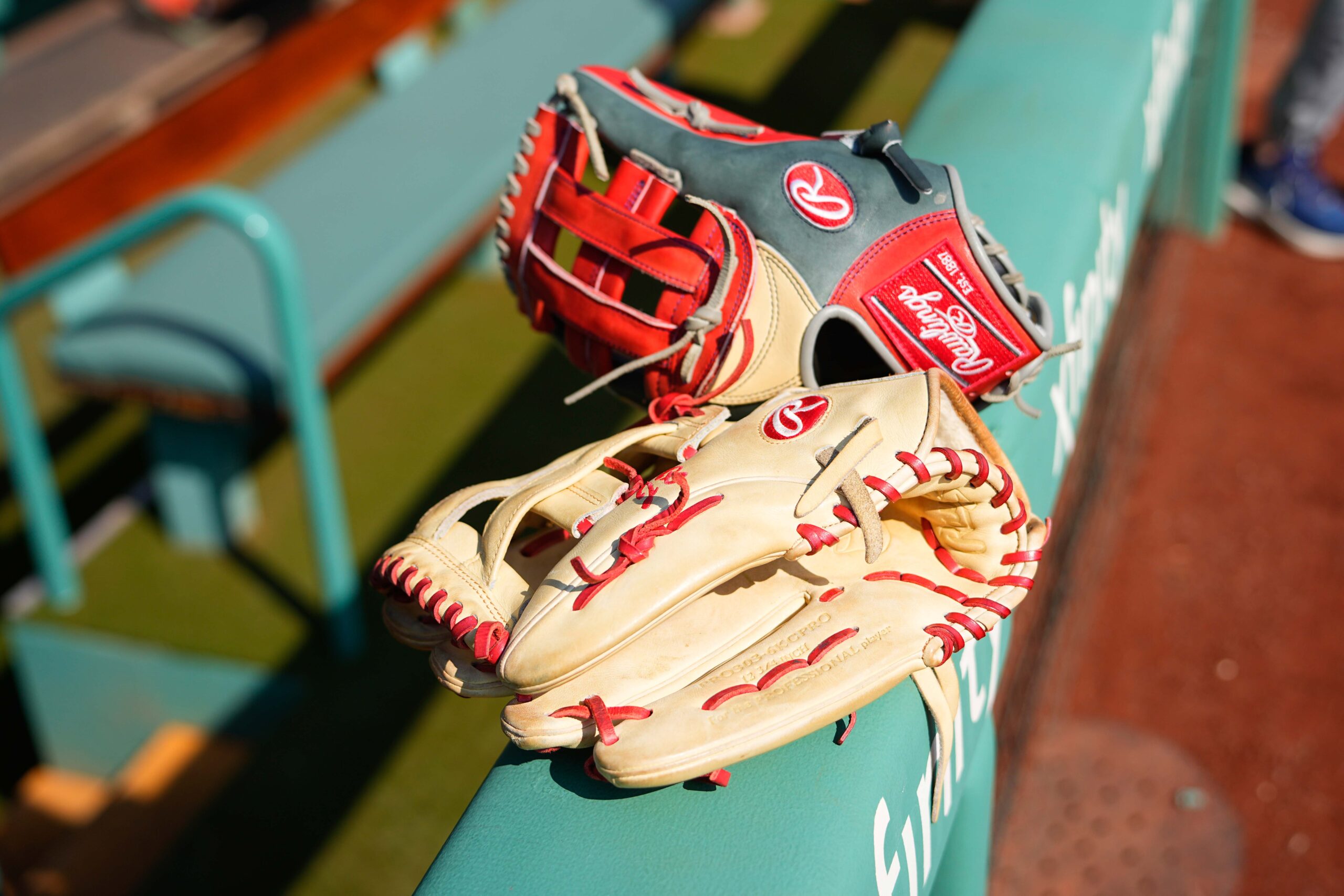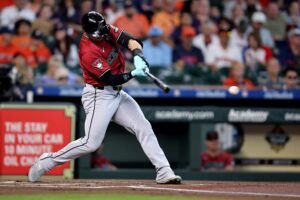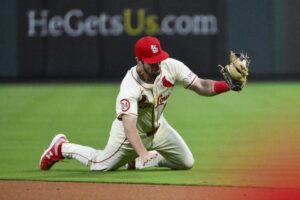Al Gionfriddo made the greatest catch in World Series history in 1947. It was better than Willie Mays’s catch in 1954.
The 1947 Series pitted the Brooklyn Dodgers against the New York Yankees. For the 1954 Series, the combatants were the New York Giants and the Cleveland Indians. The consensus among baseball fans and observers is that Mays made the better catch. Game 1 of the 1954 Series was played at the horseshoe-shaped Polo Grounds in New York. Mays was playing center field for the Giants in the top of the eighth inning with the score tied, 2-2. With two Indians on base and no outs, Vic Wertz walloped a fly ball deep toward the center field warning track. Mays took off in a flash and made a spectacular over-the-shoulder catch after seemingly running forever.
Al Gionfriddo Made the Greatest Catch in World Series History
In Game 6 of the 1947 Series at Yankee Stadium, the Dodgers were behind in games, 3-2, but ahead in this game, 8-5. In the Yankees sixth, there were two men on with two outs. Joe DiMaggio strode to the plate. DiMaggio belted a drive toward the left field bullpen near the 415 foot mark. Left fielder Gionfriddo, playing DiMaggio shallow at the foul line, turned his back to home and raced to the ball. His cap flew off. Describing it to Roger Kahn for his fine book The Era, Gionfriddo said, “I make a jump. Since I am left-handed I have to reach with my glove, which is on my right hand, over my left shoulder. . . I jump and make the reach. I’m turning in midair. I’m turning and reaching and I catch the ball. I crash the gate. I hit it hard, against my right hip.””
The great DiMaggio kicked the dirt near second base in frustration.
Delivering The Cash
Before he made the greatest catch in World Series history, Gionfriddo began his major league career with the Pittsburgh Pirates in 1944. On May 3, 1947, the Pirates traded Gionfriddo and cash to Brooklyn in exchange for five players. The official record says the cash amount was $100,000. Kahn believes it was $300,000. Dodgers general manager Branch Rickey had a conflict of interest in that his contract provided he received a percentage of cash deals whenever he sold a player. Critics accused him of favoring cash deals over player trades. The New York media wondered what Rickey wanted with the 5-foot-6 reserve outfielder. The joke in Brooklyn was that Rickey needed Gionfriddo to deliver all that cash.
You, the reader, like many baseball fans, might criticize the notion that Gionfriddo made the greatest catch in Series history. You may say Gionfriddo was out of position and should have been playing where DiMaggio hit the ball. You’ll say that you saw the catch and it didn’t look like anything special. That’s because . . .
You’ve Never Seen The Catch
The only people who saw Gionfriddo’s catch were those in Yankee Stadium on that October afternoon. Those who saw it on video saw a re-enactment. No actual footage exists.
This was brought to light in Joe Posnanski’s entertaining book, Why We Love Baseball. The 1947 Series was the first Series to be televised, albeit in limited markets. Television coverage wasn’t as sophisticated as it is today. No camera was trained on the catch. Posnanski discovered through contemporary newspaper accounts that Gionfriddo was brought back on the field the next day, before Game 7, to re-enact the catch for the newsreels. (The newsreels were the equivalent of SportsCenter in 1947.) The fans who arrived early were urged to cheer when he made the catch.

That’s why the video looks so lame and doesn’t reconcile with written eye-witness accounts (or Gionfriddo’s). It doesn’t even look like the ball was going out. However, reporter Vince Johnson, describing the play for the Pittsburgh Post-Gazette, wrote, “Almost at the gate, he turned and literally threw himself into the air. He snagged the ball in his gloved hand and fell against the barrier.” In his guest column for the Pittsburgh Sun-Telegraph, Pirates star Ralph Kiner said the ball was hit 420 feet. Kiner wrote, “I think his back was scraping the rail” as Gionfriddo made the catch. Reserve Brooklyn catcher Bobby Bragan, who was in the bullpen, told Gionfriddo the ball would have cleared the fence by three feet.
Is It The Real Video Of Gionfriddo Making The Greatest Catch In Series History?
Even before Posnanski’s book, there was controversy over whether the video of the catch was authentic. Gionfriddo always thought the footage was accurate. Doak Ewing of Rare Sportsfilms, Inc., told Rory Costello of SABR, “Anybody who thinks (the video is a re-enactment) doesn’t know film. There are a couple of different views out there, with different angles, but how could you stage that crowd?” But isn’t it possible that the re-enactment of the catch was spliced in among the actual game footage?
The famous photo shows Gionfriddo immediately after making the catch. Gionfriddo’s body is almost fully turned around. His right hip is against the fence. His cap is on the ground, to the right, in front of the 415 foot marker. To the right, one sees two small boys staring in amazement, while some smaller children are peering over the wall like orphans. To the left, a woman with a scarf over her head is open-mouthed and clapping. No other player is in the picture.
Let’s Go To The Tape
Now to the video, which I froze at various moments. The two boys are there. They could have had those seats for both Games 6 and 7. The smaller children are nowhere to be seen. It’s hard to tell whether the woman in the scarf is there, but I don’t believe so. Gionfriddo catches the ball at 12 seconds. His cap is on the ground, near his feet, to the left of the 415 foot sign. There’s a man in a suit and tie, standing in the bullpen like a church usher. The man starts applauding, rather tepidly, at 14 seconds. It took him two seconds to react to Gionfriddo making the greatest catch in Series history. Time it. That’s a long time to react. Think of how long it takes you to react to a home run by your favorite team.
At 14 seconds, Gionfriddo has not completely turned his body as he had in the photo. Here comes center fielder Carl Furillo to pick up Gionfriddo’s cap. But Furillo’s not in the photo at that point, or at all.
You’re looking at a re-enactment of the catch.
Gionfriddo Didn’t Know Yankee Stadium
As a career National Leaguer, Gionfriddo had never played in Yankee Stadium before the 1947 Series. Games 1 and 2 were played there, and although Gionfriddo was used as a pinch hitter, he didn’t play the outfield there until the Dodgers returned for Game 6. On the other hand, Mays knew the Polo Grounds. He knew he had room to run after Wertz’s drive. DiMaggio was there and saw the Mays catch in 1954. Comparing the two catches for Kahn, DiMaggio said, “On my drive, Gionfriddo had to worry about the ball and those iron gates. He had to worry about running out of room, about getting hurt. With all that, I say he made the greater catch.” Not only that, but . . .
Gionfriddo Just Entered The Game
Eddie Miksis was playing left field in Game 6. Miksis was primarily a utility infielder. He had seen occasional major league action in the outfield, too, but wasn’t a good outfielder. Sources that print play-by-play of major league games, such as Baseball Reference or The World Series by Richard M. Cohen and David S. Neft, say that Gionfriddo entered the game at the start of the Yankees sixth. They’re wrong. Reporter Filip Bondy wrote that when DiMaggio stepped to the plate, Dodgers manager Burt Shotton called time and replaced Miksis with Gionfriddo. “Miksis was having trouble picking up the ball in left, so he brought Gionfriddo in,” DiMaggio told him. So, there was Gionfriddo, coming in cold off the bench, with no opportunity to warm up, about to make the greatest catch in Series history.
Critics have accused Gionfriddo of being out of position on the play. Publicly, DiMaggio was gracious toward Gionfriddo, but privately, he groused about that, too. However . . .
Gionfriddo Wasn’t Out Of Position
Left-handed relief pitcher Joe Hatten was on the mound for Brooklyn. Shotton was certain the right-hand-hitting DiMaggio would pull the ball against Hatten. Gionfriddo was waved toward the foul line from the dugout. He noted that in old Yankee Stadium, the left field foul pole was just 301 feet from home plate. If DiMaggio made solid contact and hit it in the air, it was a sure home run. Gionfriddo decided to play shallow, to cut off a bloop single. It was the right way to play a right-handed power-hitting pull hitter. Did DiMaggio fit that description? At least against Hatten, Shotton thought so. Finally . . .
C’mon, It Was DiMaggio, For Cryin’ Out Loud!
Mays was supposed to prevail against Vic Wertz of the world. The Al Gionfriddos of the world wasn’t supposed to triumph over the great DiMaggio. Not only did Gionfriddo come out on top, but it triggered a rare emotional display by DiMaggio. That has to count for something. All things considered, Gionfriddo made the greatest catch in World Series history.
The Last Word
Gionfriddo never played in the major leagues again after Game 6. In Game 7, Miksis was in left field again. He tried to make a Gionfriddo-like catch of Billy Johnson’s seventh inning fly ball. He played it into a triple instead. Johnson scored New York’s fifth run. The Yankees won, 5-2. Gionfriddo died in 2003, at age 81. DiMaggio died at age 84 in 1999 – on Gionfriddo’s 77th birthday
Main Photo Credits: Gregory Fisher-USA TODAY Sports






